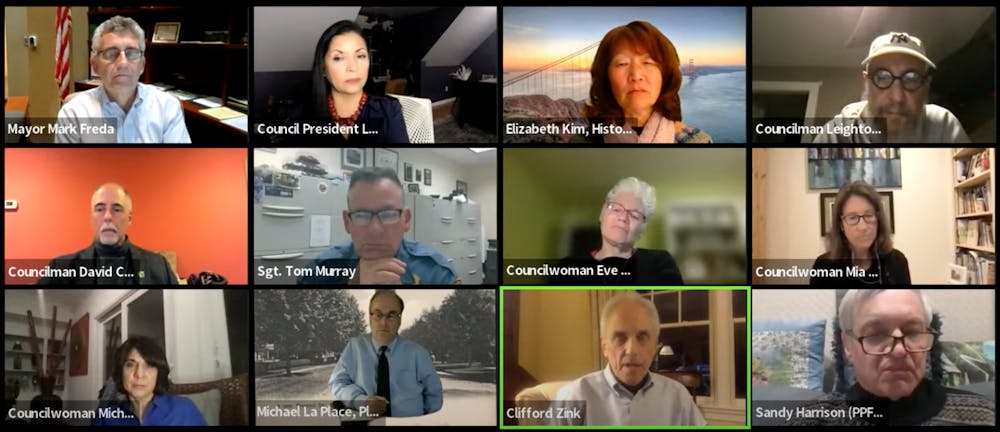At its Monday, April 11 meeting, the Princeton Town Council considered a proposal for the creation of a “historic district” along Prospect Avenue, continued to discuss the Witherspoon Phase Two renovation project, and approved the 2022 municipal budget.
The Princeton Prospect Foundation (PPF) introduced the proposal for the creation of a historic district along Prospect Avenue between Washington Road and Murray Place, an area that encompasses all of the University’s eating clubs.
The Council’s review follows unanimous approval of the proposed district by the Princeton Planning Board on Jan. 6, and a unanimous recommendation by the Princeton Historic Preservation Commission on Nov. 15, 2021.
Michael La Place, the planning director for the Municipality of Princeton, explained that the next step in the approval process is for the Council to direct staff “to formally draft an ordinance to create the district.”
Sandy Harrison ’74, the Board Chair of PPF, and Clifford Zink, a historical preservation expert and the author of the book, “The Princeton Eating Clubs,” led the formal presentation to the council and spoke in support of creating a historic district on Prospect Avenue.
Harrison began by noting that “often, municipalities in considering adopting a new historic district are reluctant to do so if there is resistance from any of the property owners within the proposed district.”
Zink assured the Council and mayor that “all of the property owners within the district, which are the eating clubs as well as the University,” support the proposal.
Harrison also emphasized that the support of the historic district by the PPF and the Graduate Inter-Club Council, which has oversight over the eating clubs, is documented in writing.

Zink provided details as to the boundaries of the proposed historic district and some of its key architectural features. He noted that the Ferris Thompson Wall and Gate will be included in the new historic district. The gate, built in 1911 and designed by the same architectural firm that designed the FitzRandolph gate, marked the entrance to the athletic field and was prominently featured in the P-Rade route until the 1980s.
Zink also mentioned that the University is working on a restoration project for the ironwork on those gates and emphasized that the purpose of “the historic district is not to freeze time and [prohibit] any changes on the street.”
He said that the district would be considered a “type two” historic district which will only require the Historic Preservation Commission’s (HPC) approval for modifications that “involve the facades visible from the right of way.” Eating clubs could continue to renovate the inside of their houses or the outside portions of the properties not visible to the street without requiring approval by the HPC.
Several public speakers and Councilmembers noted the importance of Prospect Avenue to the history of Princeton.

“There’s an architectural element, but also the human element,” said Councilmember Eve Niedergang, explaining what’s at stake in her view of the historic district designation.
Niedergang specifically highlighted “the role of African American or [the] local African American community in the eating clubs,” a sentiment that was echoed by other speakers.
Princeton resident Michael Floyd recounted his family’s history on Prospect Avenue, noting that his “paternal grandfather was the steward of Tower Club for most of the first half of the 1900s” and was “one of the lead African Americans in Princeton” at that time. Years later, Floyd’s brother became a member of Tower Club. He was happy to see that the historic preservation proposal has progressed to Council review.
Former Princeton resident Kip Cherry said he has been involved in the process leading up to today’s presentation to the Council since the beginning.
“Historic districts create a context for change around them,” Cherry said. “To put Prospect Avenue into context, this area represents a major period of change and evolution for both the town and the university and the country as a whole.”
The Town Council will consider a formal ordinance at a future meeting yet to be announced.
The Council also heard an update on Witherspoon Street construction from the Town Engineering Department, specifically about Phase Two, which stretches from Green Street to Franklin Avenue.
Last meeting, the Engineering Department proposed two options, with the major difference being one having a bike lane and the other without one. After meeting with municipal staff, the department settled on the option without a bike lane, which will include wider lanes for cars, more crosswalks and raised sidewalks for pedestrians, and 37 new trees.
The Council approved the plan unanimously, and must now approve a contract with a construction company before the Nov. 19, 2022 deadline.
The Council began the meeting by unanimously approving the 2022 municipal budget, which will increase by 0.92 percent this upcoming year.
The full meeting can be viewed here.
The next regularly scheduled meeting will be held on Monday, April 25.
Charlie Roth is a Staff News Writer and Assistant Data Editor for the ‘Prince,’ focusing on local town coverage. He can be reached at charlieroth@princeton.edu or @imcharlieroth on Twitter or Instagram.
Madeleine LeBeau is a News Contributor for the ‘Prince.’ She can be reached at mlebeau@princeton.edu, on Instagram @madeleinelebeau, or on Twitter @MadeleineLeBeau.








